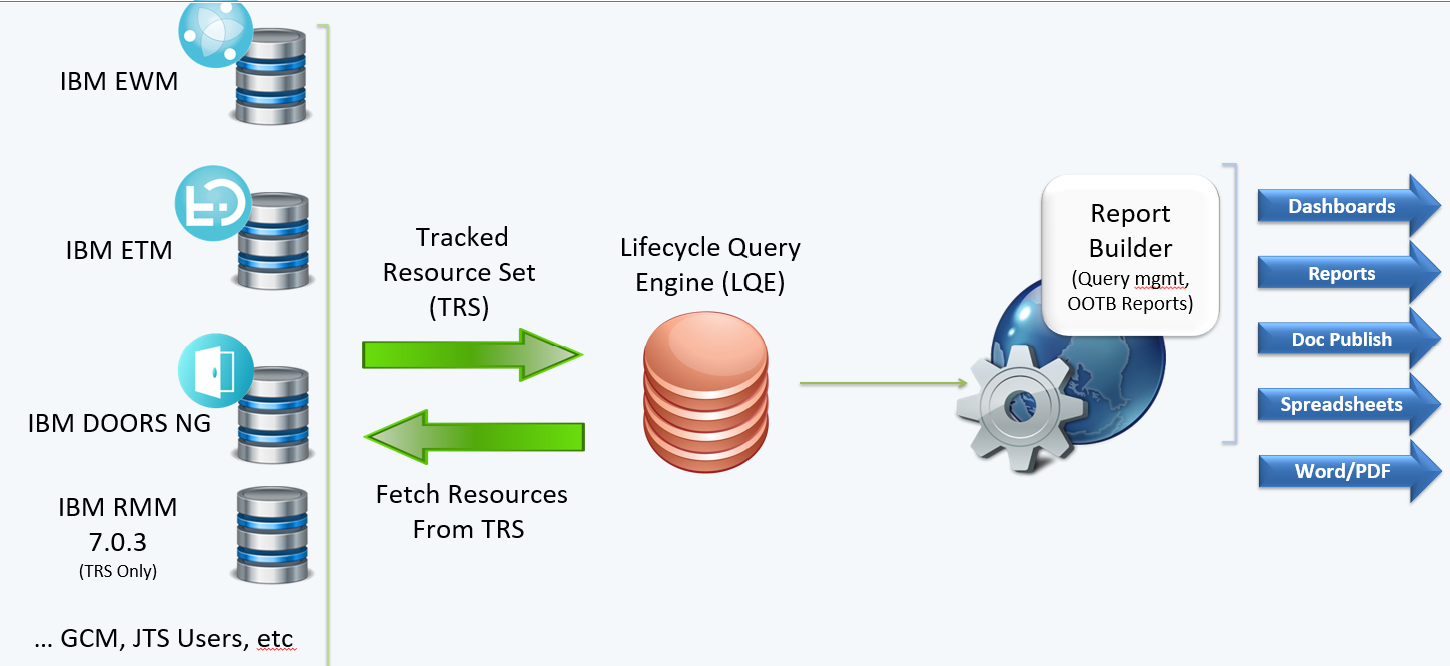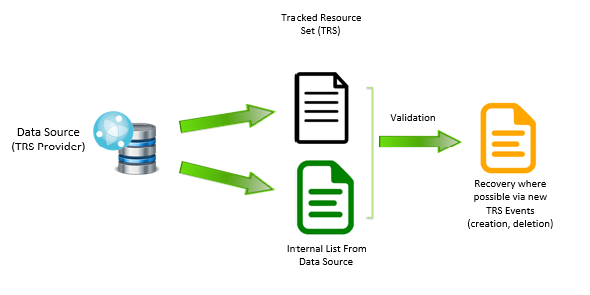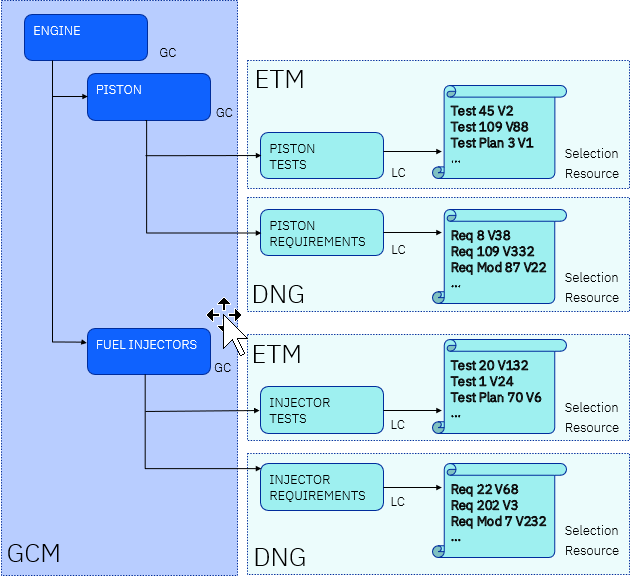Configuration aware reporting Troubleshooting
Authors: ErnestMah, RosaNaranjoBuild basis: Lifecycle Query Engine (LQE), Lifecycle Index (LDX) 7.0.x
Page contents
- Architecture
- Troubleshooting
- Reindex operations
- How can I make sure the set of data from a data provider is complete in LQE/LDX
- What can happen from the Data Provider (TRS)?
- What can happen fetching resources identified by TRS?
- In a configuration-aware report, what controls which artifacts are within scope?
- What can be done to check that selection resources are correct?
- LQE status information
The objective of page is to provide an overview of troubleshooting techniques for configuration-aware reporting.

Validation, Validation, Validation!!!!
The TRS feed is essentially the contract between the data provider and the data consumer.
A data providerís TRS defines the set of data that should be indexed by a consumer (LQE/LDX).
Key Limitation
What can lead to change log truncation?

What can happen from the Data Consumer (LQE/LDX)?
Referring to the image above...
LQE/LDX data validation
Remediation of missing data
What controls which artifacts are part of a query?
What can be done with this information? Skipped Resources
Missing Artifacts
Not up-to-date artifacts
Architecture

Troubleshooting
Reindex operations
- Reindex operation should be a measure of LAST RESORT. Only perform if requested by Support team.
- Reindex is an expensive of operation for LQE and LDX as well as the application providing the data.
- especially for large data providers such as DNG, ETM and EWM.
- Requesting a reindex essentially renders reporting from a data provider unreliable until the reindex operation is complete.
- If the root cause is not properly diagnosed, one can end up in the same state as prior to the reindex AND cause unnecessary outages.
What to check before requesting a reindex on a LQE or LDX datasource
- Check the number of threads for initial/reindexing specified for that data provider
- Ensure that the LQE/LDX has enough CPU/RAM to handle the additional work that occurs during the reindex for that data provider
- There will be 10 threads within LQE/LDX simultaneously contacting the tool providing the data. Ensure the number of CPU/vCPU is greater than this number as the remaining CPU/vCPU capacity will be used to handle other LQE/LDX operations from end users or ongoing LQE/LDX activity for other data providers.
- Ensure the application (its CPU/RAM, etc) can handle 10 simultaneous ongoing requests from LQE/LDX. The number of CPU/vCPU needs to be greater than this number as the remaining CPU/vCPU capacity will be used to handle other operations from end users of the application as well as activity within the tool itself
- If other data sources have large amounts of data being created simultaneously (large scale data imports, automated test case execution records created during builds)
- Check the number of threads for ongoing/changelog processing of each data source and add this number to the number of overall threads that are actively being used and ensure to size the LQE/LDX application
Reasons and considerations for reindexing all datasources again
- If an LQE/LDX system was overloaded with continuous running queries causing the number of writebacks to be exceeded from the default threshold setting, it can cause a corrupt Jena index
- You want to reset the data for any other reason
- First check the number of threads for reindexing on all the data sources
- Start by indexing the smaller data providers (not EWM, DNG, ETM) Ė these can be done in parallel as long as you add up the number of threads from the set of simultaneous data providers you want to kick off at the same time
- Next index each large data provider in a sequential manner (DNG, ETM EWM)
- As was described in the previous slide, ensure the data provider tool has enough resources to handle the indexing/reindexing load that will be placed from LDE/LDX
- If there is enough CPU / RAM to consider indexing more than one large data provider, make sure you monitor the LQE/LDX system and watch that CPU/RAM is not maxed out to an unusable level.
How can I make sure the set of data from a data provider is complete in LQE/LDX
Validation, Validation, Validation!!!!
The TRS feed is essentially the contract between the data provider and the data consumer.
A data providerís TRS defines the set of data that should be indexed by a consumer (LQE/LDX).
- Data provider validation operation checks the TRS is accurate to the Data provider's representation.
- Data consumer validation checks that the consumer (LQE/LDX) index (datasources) has the same set of Data.
Key Limitation
- Does not check the content of resources <elaborate?>
- Global configurations can contain other global or local configurations
- Local configurations have selection resources that define the set of versioned artifacts that are a part of the baseline or stream
What can happen from the Data Provider (TRS)?
- Data Provider server or Network path temporarily down
- LQE/LDX app logs issue fetching TRS and will retry at next interval
- TRS change log truncation - last read change log event not present in TRS
- LQE/LDX cannot proceed safely with indexing as there could be missing events Ė must reindex
What can lead to change log truncation?
- a defect during change log maintenance
- a data provider or LQE outage longer than 7 days
-
why do I need to mention the 606 IFix003 improvement? 6.0.6 ifix003 Ė Increase resiliency of overall system by increasing change log event retention period to 14 days for the n-1 version of the TRS base document or 28 days from the current version
-
- TRS content prior to LQE/LDX's last known event is modified
- LQE (7.0) will review one interval priorís set of change events to see if there are any discrepancies. If there are, it will log the discrepancies and attempt to process the events.
- TRS provides patches that are invalid
- Before state (eTag) does not match what is in LQE/LDX
- LQE (7.0) will refetch the resource at a later interval to recover * TRS content is not accurate compared to the data providerís repository * Action required is a data provider TRS validation. for example, RM TRS validation.

What can happen from the Data Consumer (LQE/LDX)?
- LQE/LDX server or Network path temporarily down
- LQE/LDX resumes indexing from last known event per data provider at the next interval
- Content of the LQE/LDX does not match what is supplied in TRS
Referring to the image above...
LQE/LDX data validation
- Compares the set of resources in the index with the Tracked Resource Set (TRS)
- Utilized eTags for comparisons
- EWM TaP TRS contains eTags for all artifacts
- Configurations modified with patch events in the changelog contain eTags (Global Config Management, RM, ETM) (RMM, SCM Future)
What can happen fetching resources identified by TRS?
- Server or network temporarily down (transient)
- LQE/LDX captures resources it is unable to fetch during the interval into the Skipped Resources list
- Administrators can manually retry the entire skip list for recovery
- LQE/LDX auto retries for skipped resources (*needs to be enabled by LQE or LDX Admin)
- Application fails to return the artifact
- Check Skipped Resource Diagnostic page from Data Provider
- Run data provider complimentary diagnostics coordinated with skipped resource list
- Manage skipped resources
- Ignore skipped resources
- remove from TRS feed
- ability to provide comments for ignoring skipped resources (EWM 7.0.1, ETM 6.0.6.1 or later, DNG (target next release??)
- Ignore skipped resources
Remediation of missing data
- Identify the data provider (ELM application) that owns the missing data
- Ensure validation has been run at the data provider level - this operation compares the data provider TRS to the actual data in the repository and records the results
- Validation results that show repairs can provide data provider developers an idea of where to look for issues.
- Repairs done by the validation operation may fix the issue but best practice is to run a corresponding LQE/LDX validation for that data provider.
In a configuration-aware report, what controls which artifacts are within scope?
What controls which artifacts are part of a query?
- User's access permissions
- Project permission - DNG, ETM, SCM/RMM
- Project or category/Iteration permission - EWM
- Configuration scoped reports
- Full Configuration hierachy
- GC containing other GCs or LCs b. GC - Global configuration comes from GCM c. LC - Local configuration comes from ETM, DNG, SCM/RMM
- Selections Resource - list of versioned artifacts
- GC containing other GCs or LCs b. GC - Global configuration comes from GCM c. LC - Local configuration comes from ETM, DNG, SCM/RMM
- PLUS unversioned resources
- If GC<->EWM release mapped, artifacts and contained links will only be returned if GC is selected for which the link to the workitem is mapped.
- Full Configuration hierachy

Report Builder - Data Completeness Checker
- Focus on a single global or local configuration to determine if everything that is referenced by the configuration is available to be considered by the report
- Unable to determine if the query itself would have included it or filtered it out (if a requirement is skipped, or missing it canít know what are the properties/relationships of that requirement)
- Reduces the scope of what it reports to only those referenced by the configuration selected. Does not focus on all skipped resources.
- looks for resources that the configuration is looking for but arenít included in the TRS itself
- Running it once for that configuration is enough to know the status of what may be missing which could affect any reports run against that same configuration
- Do not need to run it for every report
- Slows down reports by up to 20%, which is why it should be only run on demand, not enabled across the entire system.
What can be done with this information? Skipped Resources
- Inspect the URL. Based on the URL, are these artifacts involved in the report at all? If not, you can ignore them
- If the artifacts are involved in the report, retry the skipped resource from LQE and observe if it can now be retrieved.
- If not, report the issue against the ELM application providing the data
Missing Artifacts
- This represents artifacts that were never found in the TRS from the data provider.
- If a data provider validation does not properly fix the TRS to include this artifact, report the issue against the data provider
- If it is in the TRS from the data provider, then run LQE/LDX validation against the datasource from the data provider
Not up-to-date artifacts
- Go to the LQE admin view for the datasource
- Go to the Invalid update/patch tab and attempt to repair it there
- Work with the data provider to see if there is a way to repair the selection resource for that configuration (L3 TRS Selections Validation/Repair Tool tool for RM)
What can be done to check that selection resources are correct?
- RM L3 TRS Selections Validation/Repair Tool (trsSelections.jar)
- ETM - force refetch of selections via ETM TRS console
LQE status information
Detailed Lifecycle Query Engine status information available in Report BuilderRelated topics: TroubleShooting , TRS Validation
| I | Attachment | Action | Size | Date | Who | Comment |
|---|---|---|---|---|---|---|
| |
2023-08-01_12-59-00.png | manage | 218.4 K | 2023-08-01 - 17:02 | RosaNaranjo | TRS Reporting Architecture |
| |
2023-08-01_13-23-00.png | manage | 29.1 K | 2023-08-01 - 17:23 | RosaNaranjo |
Contributions are governed by our Terms of Use. Please read the following disclaimer.
Dashboards and work items are no longer publicly available, so some links may be invalid. We now provide similar information through other means. Learn more here.

